
One of our reporters recently drew the enviable assignment of visiting this year’s Nippon no Umai, an annual event sponsored by Kirin that brings the best of Japan’s regional delicacies together under one roof. With so many tasty options on display, those of us not lucky enough to attend the tasting session, held at the super swanky Imperial Hotel in Tokyo, would have to settle for living vicariously through our correspondent’s report after he returned.
We were a little underwhelmed when we asked what he’d eaten, and his answer was “white rice with salt!” but we soon came to understand why he was looking quite so content.
Japan’s mountainous topography and numerous civil wars have meant that despite being a compact country, until the nation’s relatively recent modernization and political unification, the food cultures of different regions evolved largely separately from one another. When coupled with the societal value placed on tradition and doing things the proper way, almost every locality has a culinary specialty it’s considered to do better than anywhere else.
The 2013 Nippon no Umai event featured several of these, including high-grade domestic beef from Shimane and Sendai Prefectures that are stepping up their efforts to wrest away Kobe’s crown as king of the cow meat. Representatives from Tokushima Prefecture in Shikoku showed up with their home’s delectable awa-odori chicken, as did delegates from Ishikawa and Kochi Prefectures with prized yellowtail sashimi and seared bonito.
And what did southern Kumamoto Prefecture bring to this all-out gastronomic rumble?
Salted rice balls.
Seriously? You expect people to save room for white rice with salt when they could be enjoying gourmet seafood such as abalone from Mie, or even death-defying fugu blowfish from Yamaguchi?
As time went by, though, our reporter’s disdain for the Kumamoto group’s apathy transitioned to pity at just how completely outgunned they seemed. Since a saint-like level of empathy is one of the most important criteria in becoming a member of the RocketNews24 team (surpassed only by the need for a pleasing smell), he decided that he could try just a nibble. After walking over to their booth, he picked up a plate with an unimpressive-looking rice ball on it, took a bite, and immediately realized he owed everyone in Kumamoto an apology.
When people in Japan think of where the tastiest rice comes from, Niigata and Akita Prefectures usually spring to mind. Kumamoto doesn’t really have much of a reputation for growing Japan’s favorite grain, but the salted rice balls their representatives brought to the event were nothing short of fantastic. “If I’d known they were so good, I would have made one the first thing I ate,” our reporter told us.
What made these rice balls so great was the special kind of rice used. Among the varieties of rice available in Japan, koshi hikari is generally held to be the best-tasting. This variety was crossbred with hino hikari, a type of rice grown in Kumamoto and awarded the prefecture’s highest award for flavor in 2001, to produce a new breed called Mori no Kuma-san, or “bear from the forest”, from which the Kumamoto group’s salted rice balls were formed.
Although not nearly as well-known as koshi hikari, Mori no Kuma-san is no less delicious, with each kernel cooking up soft and fluffy. The rice has a delicate sweetness that spreads through the mouth as you chew, and combines with the added salt for a near-perfect harmony of flavors.
So on behalf of RocketNews24, we’re sorry for ever doubting you, Kumamoto. Here’s hoping we get to see you again at next year’s event, and that you bring back the same tasty treats.
Photos: RocketNews24
[ Read in Japanese ]

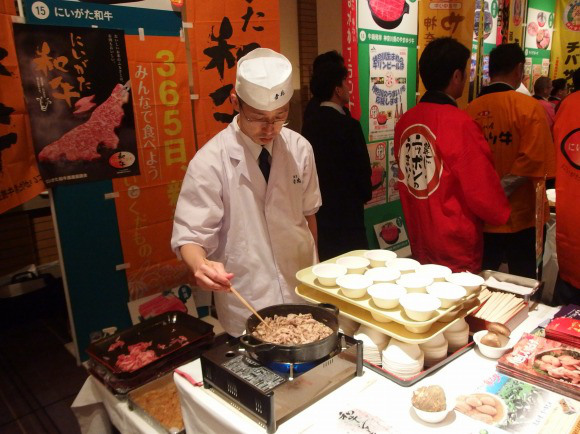
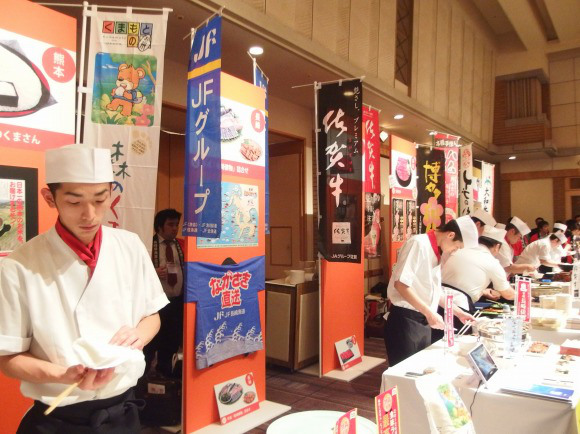
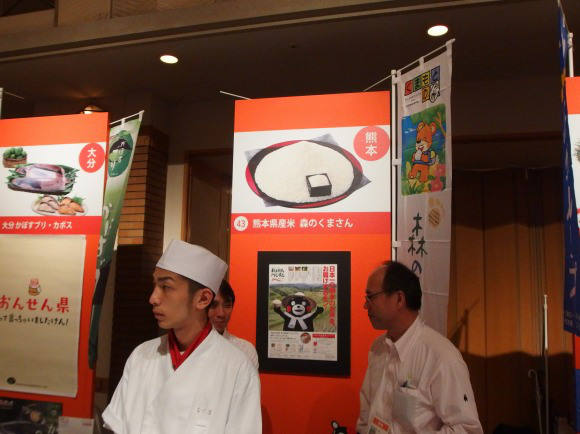
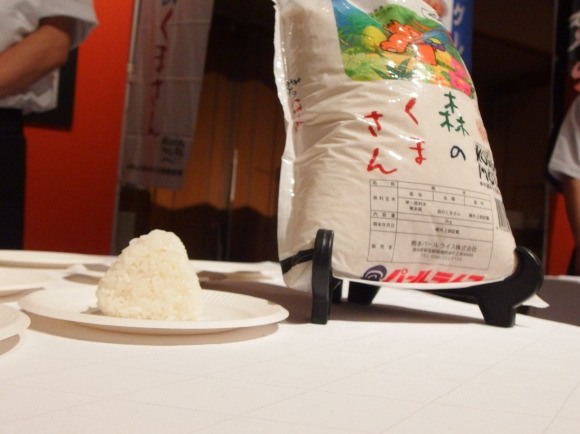
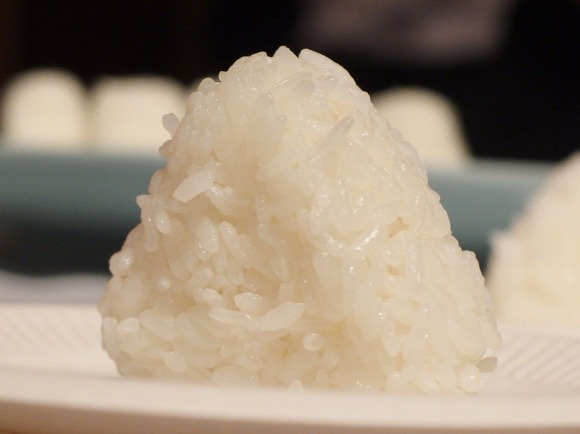
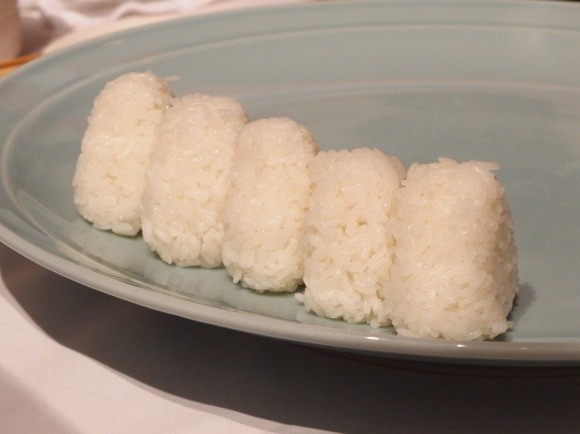
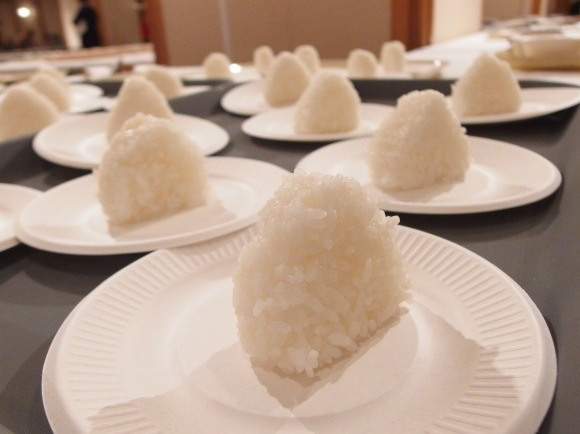
 Is anime making otaku eat less rice? Government launches Girl Running Late with Rice Ball Project
Is anime making otaku eat less rice? Government launches Girl Running Late with Rice Ball Project The Big Bomb Onigiri Japanese rice ball helps us conquer mountain race but conquers us in the end
The Big Bomb Onigiri Japanese rice ball helps us conquer mountain race but conquers us in the end Say hello to the Big Bomb Onigiri, a beast of a Japanese rice ball
Say hello to the Big Bomb Onigiri, a beast of a Japanese rice ball What are Japan’s best, and most unique, regional rice balls?
What are Japan’s best, and most unique, regional rice balls? My Neighbor Onigiri-kun – Ghibli’s Toshio Suzuki draws character for rice ball salt packaging
My Neighbor Onigiri-kun – Ghibli’s Toshio Suzuki draws character for rice ball salt packaging Pizza Hut Japan’s hot lucky bags are perfect for a New Year’s pizza party
Pizza Hut Japan’s hot lucky bags are perfect for a New Year’s pizza party Harajuku’s new permanent Tamagotchi shop is filled with cuteness and a surprising lack of poop
Harajuku’s new permanent Tamagotchi shop is filled with cuteness and a surprising lack of poop We found possibly the quietest Japanese-style hotel in Tokyo’s bustling Shinjuku district
We found possibly the quietest Japanese-style hotel in Tokyo’s bustling Shinjuku district How to easily make Salmon & Cheese Grilled Rice Balls, a tasty camp food【SoraKitchen】
How to easily make Salmon & Cheese Grilled Rice Balls, a tasty camp food【SoraKitchen】 Haunted hospital near Mt Fuji re-opens after renovation at Fuji-Q Highland, and it’s terrifying
Haunted hospital near Mt Fuji re-opens after renovation at Fuji-Q Highland, and it’s terrifying Tiny house by Muji finally goes on sale in Japan
Tiny house by Muji finally goes on sale in Japan Beautiful Starbucks in Kyoto blends into its traditional landscape in more ways than one
Beautiful Starbucks in Kyoto blends into its traditional landscape in more ways than one Japanese thug wear from Birth Japan perfect for those breaking bad next year
Japanese thug wear from Birth Japan perfect for those breaking bad next year We make a DIY face gel out of yuzu seeds, and it’s surprisingly cheap and easy!
We make a DIY face gel out of yuzu seeds, and it’s surprisingly cheap and easy! 7-Eleven now sells rice burgers in Japan, blurring the line between fast and convenience store food
7-Eleven now sells rice burgers in Japan, blurring the line between fast and convenience store food Starbucks Japan ready to get Year of the Horse started with adorable drinkware and plushies【Pics】
Starbucks Japan ready to get Year of the Horse started with adorable drinkware and plushies【Pics】 7-Eleven Japan’s ramen-cooking robot whipped us up a bowl of noodles【Taste test】
7-Eleven Japan’s ramen-cooking robot whipped us up a bowl of noodles【Taste test】 Lacquerware supplier to emperor of Japan and Pokémon team up for new tableware
Lacquerware supplier to emperor of Japan and Pokémon team up for new tableware Cyberpunk anime meets traditional culture in Ghost in the Shell gold leaf Japanese changing screens
Cyberpunk anime meets traditional culture in Ghost in the Shell gold leaf Japanese changing screens 7 great places to see Mt. Fuji from without having to climb it
7 great places to see Mt. Fuji from without having to climb it Japan may add Japanese language proficiency, lifestyle classes to permanent foreign resident requirements
Japan may add Japanese language proficiency, lifestyle classes to permanent foreign resident requirements Hello Kitty Choco Egg figures are an adorable trip through three periods of Japanese pop culture【Pics】
Hello Kitty Choco Egg figures are an adorable trip through three periods of Japanese pop culture【Pics】 Japan’s otoshidama tradition of giving kids money at New Year’s gets a social welfare upgrade
Japan’s otoshidama tradition of giving kids money at New Year’s gets a social welfare upgrade Starbucks Japan releases new zodiac chilled cup drink for 2026
Starbucks Japan releases new zodiac chilled cup drink for 2026 Can a dirty butthole make you filthy rich in Japan? We’re starting a New Year’s lottery experiment
Can a dirty butthole make you filthy rich in Japan? We’re starting a New Year’s lottery experiment 7-Eleven Japan starts new temporary luggage storage service in over 300 branches
7-Eleven Japan starts new temporary luggage storage service in over 300 branches Disillusionment at Tsukiji’s tourist-target prices led us to a great ramen restaurant in Tokyo
Disillusionment at Tsukiji’s tourist-target prices led us to a great ramen restaurant in Tokyo Starbucks teams up with 166-year-old Kyoto doll maker for Year of the Horse decorations【Photos】
Starbucks teams up with 166-year-old Kyoto doll maker for Year of the Horse decorations【Photos】 Tokyo considering law requiring more trash cans following litter increase in heavily touristed area
Tokyo considering law requiring more trash cans following litter increase in heavily touristed area Tokyo’s Tsukiji sushi neighborhood asks tour groups to stay away for the rest of the month
Tokyo’s Tsukiji sushi neighborhood asks tour groups to stay away for the rest of the month Nintendo’s Kirby now delivering orders at Kura Sushi restaurants, but not in Japan
Nintendo’s Kirby now delivering orders at Kura Sushi restaurants, but not in Japan Tokyo event lets you travel back in time, for free, to celebrate 100 years since Showa era start
Tokyo event lets you travel back in time, for free, to celebrate 100 years since Showa era start Sanrio theme park in Japan announces plans to expand into a Sanrio resort
Sanrio theme park in Japan announces plans to expand into a Sanrio resort Stamina-destroying “Paralysis Noodles” are Tokyo’s newest over-the-top ramen innovation
Stamina-destroying “Paralysis Noodles” are Tokyo’s newest over-the-top ramen innovation Survey asks foreign tourists what bothered them in Japan, more than half gave same answer
Survey asks foreign tourists what bothered them in Japan, more than half gave same answer Japan’s human washing machines will go on sale to general public, demos to be held in Tokyo
Japan’s human washing machines will go on sale to general public, demos to be held in Tokyo Japan’s deadliest food claims more victims, but why do people keep eating it for New Year’s?
Japan’s deadliest food claims more victims, but why do people keep eating it for New Year’s? We deeply regret going into this tunnel on our walk in the mountains of Japan
We deeply regret going into this tunnel on our walk in the mountains of Japan Studio Ghibli releases Kodama forest spirits from Princess Mononoke to light up your home
Studio Ghibli releases Kodama forest spirits from Princess Mononoke to light up your home Major Japanese hotel chain says reservations via overseas booking sites may not be valid
Major Japanese hotel chain says reservations via overseas booking sites may not be valid Put sesame oil in your coffee? Japanese maker says it’s the best way to start your day【Taste test】
Put sesame oil in your coffee? Japanese maker says it’s the best way to start your day【Taste test】 No more using real katana for tourism activities, Japan’s National Police Agency says
No more using real katana for tourism activities, Japan’s National Police Agency says Starbucks Japan reveals new sakura drinkware collection, inspired by evening cherry blossoms
Starbucks Japan reveals new sakura drinkware collection, inspired by evening cherry blossoms Updated cherry blossom forecast shows extra-long sakura season for Japan this year
Updated cherry blossom forecast shows extra-long sakura season for Japan this year Which Japanese convenience store has the best plain onigiri rice balls?
Which Japanese convenience store has the best plain onigiri rice balls? Which Japanese convenience store has the best salted onigiri rice balls?
Which Japanese convenience store has the best salted onigiri rice balls? Around Japan in 47 rice balls: Mr. Sato buys each prefecture’s musubi all from one Tokyo shop
Around Japan in 47 rice balls: Mr. Sato buys each prefecture’s musubi all from one Tokyo shop The 10 best types of onigiri rice balls to try in Japan【Survey】
The 10 best types of onigiri rice balls to try in Japan【Survey】 Coffee-infused rice for rice balls and curry? Taste-testing a recipe from Japan’s coffee experts
Coffee-infused rice for rice balls and curry? Taste-testing a recipe from Japan’s coffee experts Are high-end convenience store rice balls really packed with more ingredients?
Are high-end convenience store rice balls really packed with more ingredients? Japanese convenience store showdown: Who’s got the best red rice sekihan rice balls?【Taste test】
Japanese convenience store showdown: Who’s got the best red rice sekihan rice balls?【Taste test】 Tapioca onigiri brings boba to the world of rice balls
Tapioca onigiri brings boba to the world of rice balls The surprising semi-secret ingredient in many Japanese convenience store rice balls: oil
The surprising semi-secret ingredient in many Japanese convenience store rice balls: oil We make salt from our reporter’s sweat, then taste the world’s first Mr. Sato Salt rice balls
We make salt from our reporter’s sweat, then taste the world’s first Mr. Sato Salt rice balls In celebration of Onigiri Day, we compare rice balls from three different convenience stores
In celebration of Onigiri Day, we compare rice balls from three different convenience stores Less than half of Japanese people OK with bare hand-pressed rice balls, survey says, but why?
Less than half of Japanese people OK with bare hand-pressed rice balls, survey says, but why? 7-Eleven apologises for cockroaches in onigiri rice balls
7-Eleven apologises for cockroaches in onigiri rice balls Are Family Mart’s new “exquisite” rice balls worth the high price tag?
Are Family Mart’s new “exquisite” rice balls worth the high price tag? KFC Japan releases official onigiri rice ball, miso ramen rice recipes to level-up fried chicken
KFC Japan releases official onigiri rice ball, miso ramen rice recipes to level-up fried chicken
Leave a Reply